Classic Architecture And Strange Art
We have a promising day with bright sunshine, blue sky and only a few small clouds when the Oceania Marina enters Helsinki harbor. A Celebrity cruise ship follows in our wake, passing between the small ice age islands forming the harbor entrance.
From the cruise dock, we take a shuttle bus provided by the Helsinki Tourist Board to Market Square, a major landmark near the city center and by the harbor edge. Stepping off the bus, we’re greeted by the statue of a tall cartoonish pink-colored man peeing into the harbor.
Our first Helsinki landmark! Although prominently displayed, the statue is here only temporarily. The previous summer the statue (or is it a mobile fountain?) known as Bad Bad Boy was featured in a different Finnish city. Not everyone in Helsinki is happy to have the statue here. A member of the Helsinki tourist board is embarrassed to admit the statue locally is known as “The Peeing Man” or something similar. He says it’s temporarily present for an upcoming Helsinki fringe/arts festival.
The statue is decidedly arresting, and its location near several government buildings could also be a political statement. Hmmm…what if this was moved to Washington, D.C., and the Bad Bad Boy’s spray aimed at Congress. Most Americans would love it, based on the opinion polls of the last two years.
Classic Helsinki Highlights
Behind the “The Peeing Man “ statue the historic green and gold onion domes of the Uspenski Cathedral rising above a small grove of trees a few blocks away. Uspenski Cathedral is the largest Orthodox Church in Western Europe. Its golden cupolas and deep red brick facade gleam in the sunlight, a popular photo subject for the numerous tourists roaming the cathedral’s grounds. Uspenski cathedral, built between 1862 and 1868 and designed after a 16th century church near Moscow, is one of many lingering but still popular monuments related to past Russian dominance. (By treaty, Finland was annexed from Sweden to Russia in 1809 as the Russian Grand Duchy of Finland until Finland gained its independence in 1917.)
It’s a short downhill walk from Uspenski Cathedral to Senate Square and the Helsinki Cathedral, two more of Helsinki’s best-known historic landmarks. Helsinki Square is a large open area bordered by the University of Helsinki, Government Palace as well as Helsinki Cathedral, the Square’s main attraction.
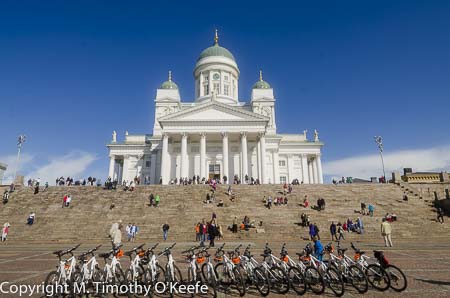 Bikes lined up below Helsinki Cathedral
Bikes lined up below Helsinki Cathedral
The neoclassical cathedral, also known as Toumiokirkkor and the Church of St. Nicholas, is also designed after another Russian church, this one in St. Petersburg.
Most countries topple the statues of their former rulers once they gain freedom, so it’s surprising the statue of Russian Tsar Alexander II is still a prominent Senate Square landmark and that the statue’s base is richly decorated with flower baskets. Tsar Alexander II obviously earned enduring gratitude from Finns as a result of his reforms that increased Finland’s autonomy from Russia. Once Finland gained its independence, there definitely was talk of removing the statue, yet Alexander II remains, a very popular place for family photos and selfies.
There’s a festive air in Senate Square today, as if everyone is waiting for a marching band or a rock concert to start. Concerts indeed are held here but not today. Time for us to move onto Helsinki’s famous bronze mermaid statue locally known as Havis Amanda.
The Mermaid Trapped in a Box
Where is the celebrated bronze mermaid standing on seaweed as she rises from the water? The statue, Helsinki’s unofficial symbol, is nowhere to be seen in the wide open spaces of Market Square. We learn she has been “disappeared” by city officials for reasons that sound like a bad Saturday Night Live comedy sketch. It seems the Helsinki Art Museum chose an artist to hide the iconic image inside a big black box—the Hotel Manta–which also is considered an inspired work of art. To me, Hotel Manta looks as “inspired” as a cheap prefab plywood box. I don’t get it. Or the idea of removing the mermaid statue from public view by another art object. This is like New York City deciding to hide the Statue of Liberty inside a black skyscraper.
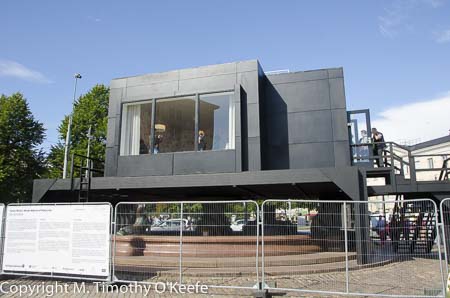 Art hides art as Hotel Manta obscures the famous bronze mermaid
Art hides art as Hotel Manta obscures the famous bronze mermaid
However, it soon becomes apparent the real purpose of Hotel Manta is to be a cash cow for the city. There’s now a 3 euro fee for the privilege of viewing the caged mermaid standing inside a hotel room instead of outside under the sun. Even more money is generated by renting out the hotel room at night for those wanting to sleep with the mermaid inside the fenced off, elevated observatory over Market Square. (The hotel stopped taking reservations following the summer season.)
Ironically, the mermaid’s confinement to a hotel bedroom may have fulfilled the worst fears of some Finns when the mermaid first appeared in Helsinki in 1908. Those objecting to her nudity considered her a “whore.” Made to pimp for tourist money, some might say that’s what she’s become. We like to think the hotel is present to raise money for any needed restoration of the statue so she can return to the outdoors, though we saw no indication the hotel was only a temporary prison.
Taste of Finland
We wander to Market Square’s famous outdoor summer market known for its variety of crafts, souvenirs and food stands. Wonderful looking vegetables and fruits, most far larger than the ones we ever see back home, are displayed in numerous stalls.
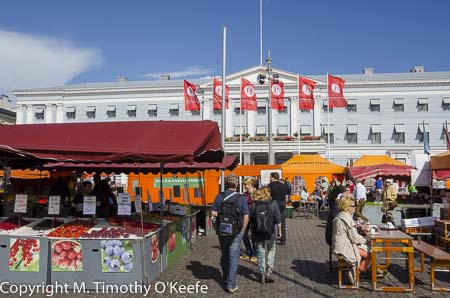 The popular summer market in Helsinki
The popular summer market in Helsinki
The most striking souvenirs are colorfully dressed dolls and other crafts from Lapland, Finland’s northern most region. Lapland’s inhabitants are known as the Sami, the indigenous people who have maintained their traditional language and culture. They are best known for their distinctive colorful clothing, for raising reindeer, traveling by dog teams and the wintertime Santa Claus Village in Rovaniemi on the Arctic Circle.
The Sami make wonderful dishes with reindeer meat. During my several visits to Lapland I developed a strong fondness for the region’s famous stew of reindeer, lingonberries and mashed potatoes. One of the things I hoped when we arrived in Helsinki is we’d find Lapp food so Linda could taste it. At a tented restaurant selling “Lapland Food” she agrees to order the stew. Then she smells the delicious aroma of ground reindeer formed into meatballs. That not only smell scrumptious but has a flavorful spicy taste. When we order, although Linda’s choice may be more flavorful I remain loyal to the reindeer stew . I’ve wanted to taste reindeer stew again for a long time.
This simple meal will be a perfect memory of Finland. Our time in Helsinki ends as jet lag catches up with us big time. It’s like we feel hung over and it’s time to take care of it. We don’t want to feel like this tomorrow in St. Petersburg. It’s back to the Oceania Marina and a long uninterrupted sleep.

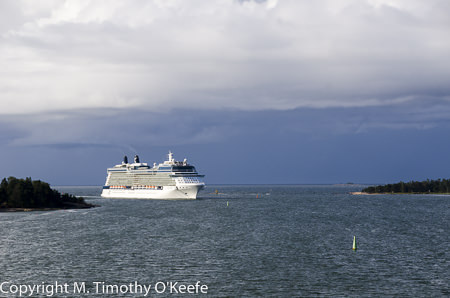
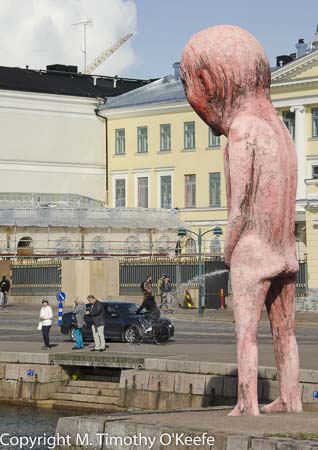
 Follow
Follow